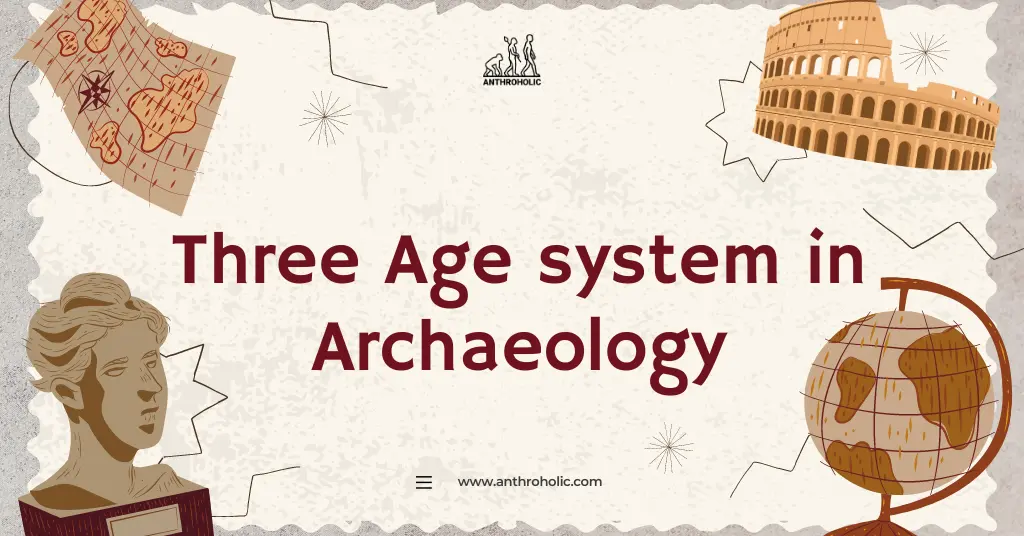AI Answer Evaluation Platform Live Now. Try Free Answer Evaluation Now
Three Age System in Archaeology
The Three Age System is a critical principle in archaeology that classifies human prehistory into three distinct time periods: the Stone Age, Bronze Age, and Iron Age. This comprehensive classification system forms the foundation for understanding the technological advancement of ancient societies [1].

Overview
The concept of the Three Age System, devised by Christian Jürgensen Thomsen, a Danish archaeologist in the early 19th century, was a groundbreaking achievement in the field of archaeology. It offered a chronological classification based on the primary materials employed for tool and weapon manufacture. While simplicity marks its structure, its importance in interpreting the progression of human societies cannot be overstated [2].
The Stone Age: First Steps into Tool Making
The Stone Age, the earliest of the three eras, was characterized by the creation and usage of stone tools and weapons. It is further subdivided into the Paleolithic, Mesolithic, and Neolithic periods, each signifying a shift in tool technology and lifestyle.
- Paleolithic Period (Old Stone Age): During this period, humans were primarily hunter-gatherers. Tools were rudimentary, often made by chipping away at a stone to create a cutting edge.
- Mesolithic Period (Middle Stone Age): This phase shows signs of transitional behavior, with humans starting to settle down and form communities. Tools became more sophisticated, including fishing and hunting gear.
- Neolithic Period (New Stone Age): The Neolithic period marked the advent of agriculture, and tools evolved to support farming and domestic needs. Polished stone tools and pottery appeared during this time.
The Bronze Age: The Dawn of Metalwork
The advent of metalworking marked the onset of the Bronze Age. It’s characteristically denoted by the creation of bronze, an alloy of copper and tin, used to make a variety of tools, weapons, and ceremonial objects. The exact timing of the Bronze Age varies geographically, as the knowledge of bronze making didn’t spread simultaneously worldwide.
During the Bronze Age, societies became more structured and hierarchical, resulting in noticeable social inequality. Large scale constructions, such as palaces and fortifications, became more prevalent during this age, symbolizing the power and might of rulers.
The Iron Age: Advancement in Metallurgy
The Iron Age was marked by the widespread use of iron or steel. The primary factor that initiated the Iron Age was the development of bloomeries, furnaces that could reach the high temperatures needed for smelting iron.
Iron tools were more durable and allowed for more efficient farming and warfare, contributing to population growth and military conquests. Writing systems, money, advanced architecture, and public works also emerged during this period, furthering societal complexity.
Understanding Transitions Between Ages
Transitions between ages weren’t abrupt but gradual processes over centuries or even millennia. Changes were usually spurred by technological innovations that slowly spread through trade, migration, or conquest. The table below outlines the approximate timeframes for each age in different regions:
| Region | Stone Age | Bronze Age | Iron Age |
|---|---|---|---|
| Near East | -7000 BC | 3300 BC | 1200 BC |
| Europe | -4000 BC | 2000 BC | 800 BC |
| China | -5000 BC | 2000 BC | 600 BC |
| Sub-Saharan Africa | -5000 BC | 800 BC | 500 BC |
Table 1: Approximate timeframes for the Three Age System in different regions
Conclusion
The Three Age System provides an invaluable framework for comprehending the progression of human society and technology. Its universal applicability and relative simplicity make it a pivotal component of archaeological and historical studies. Despite its age, it still remains one of the most widely used systems in historical analysis and archaeological teaching.
References
[1] Childe, V.G. (1951). Man Makes Himself. London: Watts.
[2] Rowley-Conwy, P. (2007). From Genesis to Prehistory: The Archaeological Three Age System and its Contested Reception in Denmark, Britain, and Ireland. Oxford University Press.




